Subscribe to blog updates via email »
July 2020 Income Report
An audio version of this income report is available to Patreon backers of certain levels »
July’s revenues were $4,963, down from June’s $7,588. Profits were $2,777, up from June’s $1,524.
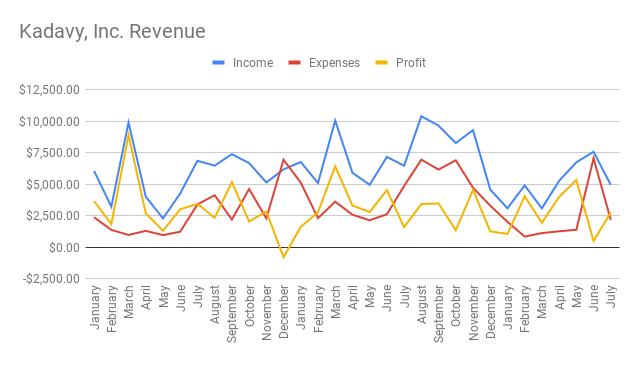

WANT TO WRITE A BOOK?
Download your FREE copy of How to Write a Book »
(for a limited time)
I’m no longer earning money from the Mind Management, Not Time Management Preview Edition. I earned just $100 in July from the Preview Edition, as I shut down sales.
I didn’t have income from the Preview Edition, so revenues were a little lower. However, I didn’t have the massive expenses of June’s BookBub Featured Deal, so profits were a little higher.
First paperback galleys of Mind Management, Not Time Management!
I finally received the first paperback galleys of Mind Management, Not Time Management! I ordered one from IngramSpark, and one from Amazon’s KDP Print.
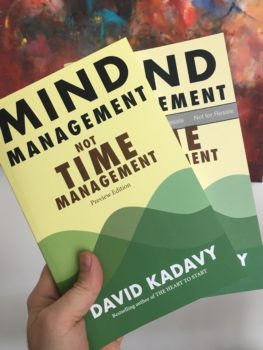
Paperbacks from IngramSpark (left) and KDP Print (right).
Thanks to a post from Carol Beth Anderson in the 20 Books to 50k Facebook Group, I realized for the first time that Ingram prints their books on thinner paper. So Ingram books come out a little thinner.

The IngramSpark book is a little thinner than the KDP Print book.
Of course this means that I had to design two oh-so-slightly-different covers for the paperback. I simply made the cover illustration and type elements into Symbols in Affinity Designer, and arranged them on slightly different artboards.
They turned out great! I thought by now I’d be used to holding one of my books for the first time, but it kind of took my breath away unboxing them.
https://twitter.com/kadavy/status/1295496249295220737
Why two different books? KDP Print is for distribution through Amazon. Amazon tends not to ship Ingram books quickly, as I’ve learned from the hardcover edition of The Heart to Start. Also, Amazon’s global distribution is not as extensive as Ingram’s, so the Ingram book is for the rest of the world, outside of Amazon.
They both share the same Bowker-purchased ISBN, and I made sure to set up the ISBN in Ingram before Amazon KDP Print, because popular folklore says that prevents independent book stores from refusing to order an “Amazon” book.
I still have to make edits – incorporating feedback from all of the comments on the Google Docs, from my wonderful beta and Preview Edition readers – and add end matter, such as end notes and acknowledgements. The final book will be about 20–30 pages thicker, with the final page count fortuitously around the genre standard of 250 pages.
I also had originally planned to redesign the interior with a custom design. These galleys are laid out using Vellum, and they look great! I’ll experiment with laying out the interior in Affinity Publisher, as I had originally planned. I had also planned on using the template I created for The Heart to Start for laying out the ebook version in Sigil.
All of that is a lot of extra work, so I’ve considered just going with the Vellum layout. But, as a designer, it’s hard to resist having that extra control. (Read my post on the best places to order advance reader copies.)
Mind Management, Not Time Management Kindle edition available for pre-order!
Just a reminder that the Kindle edition of Mind Management, Not Time Management is now available for pre-order on Amazon!
If you already bought the Preview Edition, I’ll be sending you the ebook of the First Edition when it comes out. Otherwise, pre-order Mind Management, Not Time Management today!
Galleys going out to early reviewers
Another good reason to have an Ingram edition of the book is it allows you to send Advanced Reader Copies (ARCs) of your book.
I’ve been sending out galleys to podcast hosts, people I’d like to have blurb the book, and other influencers. This is the part where it starts to feel worth it to have interviewed a bunch of people for my podcast over the past several years. It’s so much easier to email someone you’ve already talked to for an hour than it is to do cold outreach! As Noah Kagan has said, plant your garden before you’re hungry.
Ordering ARCs from Amazon KDP Print
Ordering ARCs from Amazon KDP Print is possible, but it has two drawbacks:
- Amazon KDP Print ARCs are not easy to order. You have to request permission, then Amazon sends you a link to buy the “proof.” This link expires within 24 hours, so you have to act quickly.
- Amazon KDP Print “ARCs” aren’t really ARCs – they’re proofs. Thus they come emblazoned with the “Not for Resale” band that you see in the images I shared above.
The ordering process is prohibitively cumbersome if you’re sending out dozens of copies. The “Not for Resale” graphic is ugly, and totally unacceptable if you’re sending out copies to an influencer who might share the book on social media.
Ordering ARCs from IngramSpark
So, all of the paperback galleys I’m sending out are going through IngramSpark. The one drawback of IngramSpark is that they charge you per upload of your design files. I think it comes to about $75 for your first upload, and then $25 per additional uploads – with the interior and cover counting for separate uploads.
As you can see, this could get expensive. Which is why it helps to have an Alliance of Independent Authors membership. They have a coupon code which completely waives Ingram’s upload fees, so their membership fee pays for itself pretty quickly. My affiliate link is kadavy.net/alli.
Aside from that, ordering ARCs through IngramSpark is a breeze. I have a process set up for my assistant to order them.
Ebook ARCs through Bookfunnel
More and more early readers prefer to get an electronic copy of the book, which works out because launch day is coming, and ebooks ship a lot faster!
I can simply email files to early readers, but it’s also nice to use Bookfunnel. It guides people through a couple of questions to deliver the right format to each reviewer. I’m not really concerned with reviewers doing anything nefarious with electronic galleys, but Bookfunnel also watermarks each copy with the contact’s information.
Managing ARCs with Airtable
I’ve used Airtable for managing the Love Your Work schedule for years, and have also been using it to manage the Love Mondays schedule. It’s hard to describe what makes it different than Google Sheets, other than that it’s way better-designed!
I set up an Airtable base with contacts to whom I plan to send ARCs. I had experimented with simple lists in Evernote or Notion, but they didn’t stick. Notion could probably do what I’m doing with Airtable, but as I’ve mentioned, it’s better if you can reduce the number of tools you’re using, without much loss of functionality.
Some things I track in my Airtable base:
- Phase: Will I send them the Preview Edition galley, wait until I have a formal “pitch sheet,” wait until I have a First Edition galley, or wait until the First Edition is ready?
- Ask: Am I asking for a blurb, a podcast appearance, or other media coverage? Or, are they simply a “wildcard”?
- Status: Have I pitched? Do I have shipping information and is it thus marked “Ready” for my assistant to send? If no response, have I followed up?
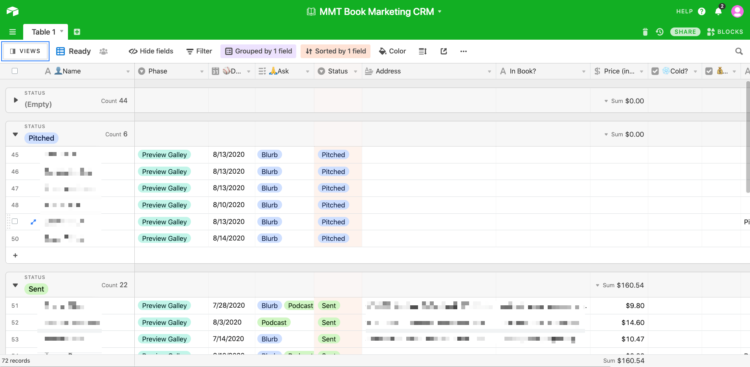
If you haven’t tried out Airtable, I highly recommend it. Someday I hope to share some of the cool automations I’ve set up using it and Zapier. For example, I use Airtable to capture my successful tweets, which I then use as a starting point for writing Love Mondays emails.
I still haven’t used Airtable enough to have to pay for it, but if you sign up through my link, I’ll get $10 credit.
Picking up edits on Mind Management, Not Time Management
Along with my first paperback galleys, I’m also excited to have the first printed manuscript of Mind Management, Not Time Management!
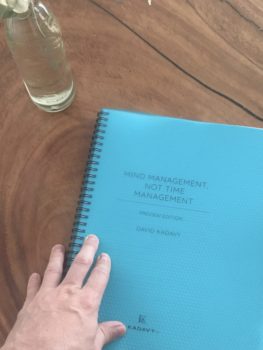
This was surprisingly complicated to get, with Colombia’s strict lockdown procedures. You’re allowed one day a week – based upon your ID number – to run errands. The print shop had some technical difficulties and took four days to finish and deliver this.
Why a separate “manuscript?”
You might wonder, why bother with this printed manuscript when you have the paperbacks? This format lays flat easily, and I set it up to have a big margin down each side. This way I can comfortably set up on my dining table and mark up this manuscript with a pen.
In addition to my own comments, I also have reader comments in a Google Doc, from beta and Preview Edition readers. I saw all of those comments as they came in over the previous months. At the time, I was still working on the manuscript, so I simply made a mental note of each one as it came in, then ignored it.
My process now is to read the manuscript, mark it up with my own notes, then go through the Google Doc, addressing my own notes, along with reader comments.
I also have audiobook roughs I created when I finished each chapter – just really rough audio files I recorded with iPhone headphones, and which I’ve loaded onto Overcast. My routine this week is to listen to a chapter while I walk in the park, then come home and mark up the chapter in the manuscript, then go make edits in the Google Doc.
The many versions in a book’s process
It’s tricky in this process to keep track of which version is which, and in which version certain changes have or haven’t been made. This manuscript is created in Vellum – it’s the same file as the paperback, just exported with different specs. The Google Doc for each chapter has the same content, but it’s of course a different file. After I edit each chapter’s Google Doc, I’m then pasting its contents into a final manuscript Google Doc. All the while, I’m listening to these audiobook roughs, which may be slightly different.
This is all separate from the Scrivener file, in which I actually wrote the Preview Edition!
Once this final manuscript Google Doc is complete, I’ll export it into the paperback and ebook templates. At that point, it will be in separate files, so any errata fixes will have to be made in two places. Add to that that I like to have an ebook version just for Amazon, and another version for everywhere else, and that makes three places. Having two ebook versions allows me to include Amazon links to my books in the Amazon version, and also solicit ratings and reviews at the end of the book.
I’m still not sure whether I’ll be able to launch with the audiobook version, but that is yet another version, which is even harder to edit than the others. It’s a lot to keep track of! It makes even more attractive the prospect of doing both paperback and ebook layout in Vellum – both versions work from the same source text!
Designing my thoughts
I continue to experiment with new tools and ways of managing my thoughts to reduce friction in turning those thoughts into finished products.
So, I continue to experiment with a Zettelkasten, or a database of notes from my reading, and of my own thoughts and ideas.
I’m noticing that reviewing things I’ve read, so that I can synthesize those things into notes, takes some extra mental energy. While I’m always trying to spend some time reading every day, I’m now finding that I’m allocating some of that time to taking notes on what I’ve read.
Going from lamp-shaped to pot-shaped?
My initial impression is that I may be going from a “lamp-shaped” process between consuming and creating, to a “pot-shaped” process.
Is your consume/create funnel lamp-shaped, or pot-shaped?
Lamp-shaped: You read a lot, retain little, and publish even less
Pot-shaped: You read a little less, retain more, and publish a lot
Which is better? pic.twitter.com/apaAP7Hr2j
— ? David Kadavy | Time ?? Mind Management (@kadavy) August 12, 2020
However, this impression may be wrong. While it does take time and energy to take notes on the things I’ve read, I’m noticing I may also be processing and retaining the things I’ve read better than I did before. Perhaps the act of note-taking is improving the reading I do when I don’t take notes.
That would make sense. As I experiment with this, I’m developing mental models for how to process both inputs from my reading as well as “inputs” in the form of my own thoughts. If I can more clearly discern between relevant and irrelevant information, and always know where an idea can go, that should improve retention.
Does note-taking make you less creative?
As I have tried to be more deliberate in processing the things I consume, I have noticed a lull in my own ideas. This could be random, it could be my imagination, or it could be a temporary reallocation of mental resources as I construct new ways of processing my thoughts.
I also have a theory that being too formal in processing other people’s ideas can leave few resources leftover to have your own ideas. If every thought you have immediately leads you to, “oh, that’s like this concept that already exists,” that could have a detrimental effect on your ability to have new and original ideas.
So, there are some potential negative consequences to being organized in how you process reading. I’m not ready to give up on it, though. So far, it’s been an enjoyable ritual to sit and take notes, and I can feel a sense of confidence building in knowing that I am recording my thoughts and learning, and may be able to trust my system for retrieving them.
Just this morning, I had a flurry of half-baked ideas come to me. I wrote some quick notes, and tagged them such as I will be able to retrieve them easily. They are relevant to my idea for a next book, working title, The Fuel to Finish. I’ll be putting my modified Zettelkasten to the test as I wrap up Mind Management, Not Time Management, and work on the next book.
State of the apps
I’m still jumping around amongst various writing and note-taking apps.
- Obsidian: I’m not using Obsidian at all on a regular basis, but that may change as I connect more notes.
- Ulysses: I’m primarily using Ulysses for taking notes in my Zettelkasten, but dear god is it buggy! The tag or “keyword” management feature is still my favorite part.
- 1Writer: My favorite writing experience is definitely 1Writer on my iPad. It’s just a clean and simple Markdown-writing experience, and it doesn’t do the annoying stuff that Ulysses does such as automatically turn anything in brackets into a link.
- Drafts: I’m still loving Drafts for quick capture of ideas. It’s where I keep running files of tweet ideas that I work on before publishing. I have actions set up for quickly sending notes to the Inbox of my Zettelkasten, or for creating tasks in Todoist.
- Notion: Notion is pretty much dead in the water for me. It’s beautiful, but the pull isn’t strong enough to make it a regular presence in my workflow.
- Evernote: I still have ten years worth of notes in Evernote, but after working with raw Markdown files, I cringe every time I try to open it on iOS. I never noticed how slow it had gotten. Still good if you’re taking notes in which you need quick capture of images.
- Scrivener: Scrivener is also dead for me at the moment. The syncing process on iOS is bloated and cumbersome. Still the best fullscreen writing experience on desktop. We’ll see if I find a reason to use it again for my next book.
Love Mondays newsletter experimentation
I spent the first half of the year obsessing over Twitter, and I’ve reached a point where I’m consistently able to post high-engagement tweets, and as a result I’m slowly but steadily adding followers, instead of losing followers.
Now I am turning my attention to my Love Mondays newsletter. This email list is not growing, and is even losing subscribers. I’ve also noticed a slight drop in open rate lately.
This is strange to me, because each week I get glowing responses from readers at how much they love the content.
My knee jerk reaction to the problem of Love Mondays not growing is to try to re-brand it, or to optimize the landing page, or to run some kind of giveaway to attract subscribers.
But I want to go beyond that, and think about why I have this newsletter in the first place. What is it for, and what am I trying to accomplish?
What is this weekly newsletter for?
My initial motivation in having a weekly newsletter was to have some kind of consistent contact with my most eager readers. To stay top-of-mind, so that when I promote, say, a book, they haven’t forgotten about me.
I originally thought I would capture a lot of leads from the podcast. I’m sorry to say, I don’t really know if I’m doing a good job of that.
I also originally wanted to capture leads from Twitter. In experimenting with Twitter, I’ve realized that Twitter hates links. But I have been sharing the newsletter in ways that brings “dark” sign-ups. I share images of the newsletter, with a short link call-to-action actually in the image. A person has to type the URL in for themself. I don’t track this, but I see some correlation in my sign-up stats. I think this is working.
I originally thought the newsletter would help drive podcast listens. The links I share to the podcast get some clicks, but I don’t know if those people are listening. Even if it made a lot of clicks, it would be hard to see that making a difference in downloads.
One motivation for including a tweet in the newsletter was to drive more engagement on Twitter. But there is little engagement with the tweets within the newsletter itself. If anything, having a tweet embedded in the email makes it seem like the content isn’t exclusive to the newsletter.
Another motivation for including a tweet in the newsletter was to have an image that the reader would be motivated to see. This, I figured, might give me more accurate open-rate numbers, and perhaps improve the sender reputation for my email address. I have no idea if this is true.
Yet another motivation for including a tweet in the newsletter is that it reduces the “cognitive load” of opening the newsletter. I know there are newsletters I subscribe to that have small tidbits in them, and those are the ones I open first. The ones that are long walls of text are quality, but I open them last. I don’t automatically take that to mean that I shouldn’t have long walls of text. After all, I’m ultimately selling people books. But, it does seem that smaller bites have a better chance of keeping a newsletter top-of-mind in a larger number of people.
The final motivation for including a tweet was that it helped make the newsletter a repeatable system. I’m already tweeting, why not take the best ones, and build upon them? Why not turn it into a system that I can easily delegate?
How can I make the newsletter better?
Now that I’m confident in staying consistent with the newsletter, and now that I’m freeing up some creative energy as I finish Mind Management, Not Time Management, I have some energy to think about how to improve Love Mondays.
In this latest batch of emails, I’m running some tests. I know, hell must be freezing over if David Kadavy is doing A/B tests. But remember, my issue with A/B tests is when people think they can use them as a substitute for creativity. I’ve spent many years finding my voice and honing my work into something unique that people want. Now I can use tests to tweak and see if I’m going about it the right way.
Some things I’m testing:
- Should the subject line say “Love Mondays” in it? Initial numbers on this suggest that it leads to a lower open rate, but this variation had zero unsubscribes (compared to 9). My newsletter isn’t growing because I’m losing as many subscribers as I’m gaining. Perhaps this reminds people why they’re on the list?
- Should the tweet be in the image, or in plain text? I’ll be interested to see the open rates on this. Does having the tweet as an image help more opens register? Of course, there’s also the question of whether there should be a tweet in the newsletter at all.
- Should there be a “Welcome to Love Mondays” pre-amble? Again, reminding people why they’re on the list may prevent confused unsubscribers. As people wade through a rising tide of information, they may need more reminders.
Other questions on my mind:
- Can you on-board better? Many people end up on the list upon responding to a lead magnet, such as the creative productivity tools I offer. Maybe it comes as a surprise when they receive the Love Mondays newsletter. Can I do a better job of letting them know what’s coming?
- Is retention rate more important than open rate? One test with “Love Mondays” in the subject line led to a lower open rate, but zero unsubscribes. Is it more important to retain subscribers than it is to have them opening emails at a higher rate?
- Should you include “ABCs”? I’ve been experimenting with including what I call “ABCs”: Aphorisms (Quotes), Books, and Cool things, toward the end of each email. The thinking was to add some quick hits that subscribers might enjoy. It would encourage opens through low “cognitive load,” and keep people subscribed with “variable rewards.” However, my open rate has dropped slightly since I included this. Is it a seasonal variation? Is it random? Are more links causing it to go into spam filters? Is it increasing “cognitive load” and preventing opens? I don’t know!
- Can you increase traffic? Traffic here on kadavy.net is down. I haven’t been doing any of my old tried-and-true SEOptimized-content-marketing. It’s hard to get sign ups if there isn’t traffic going to the sign-up page.
- Can you trust your stats? I don’t trust my Google Analytics stats anymore. The number of sign-ups showing up in GA lags behind my actual sign ups. Also, the conversion rate it reports is horrible, like 5%. Can I trust those numbers? Is there a better way to get more accurate numbers? (Fathom Analytics, which is cookie-free, is tempting, but not sure I can justify the cost).
- Can you increase conversions on the sign-up page? Like I say, I don’t know if I can trust my conversion-rate stats to begin with. But I’m sure my sign-up page could be better.
- Can you make your offering more clear? To me, Love Mondays is about giving creators the mindset to commit to success. But is that a compelling offering? Is there a better way to communicate it? Can that offering be refined, maybe even in a way that alters the content of the newsletter?
- Should I rename the newsletter? I think I’ve talked here before about the name Love Mondays. It sounds like a bitter pill. I’ve thought of calling it Monday ABCs, which cognitively sounds easier and more iconic. But would a re-name really move the needle anyway?
- How much does the “darkness” matter? As people get more concerned about privacy, as the attention arms-race intensifies, as media is consumed across more and more platforms in more and more types of media, I’m thinking about “darkness.” I sense that a lot of the important stuff happens in the darkness. You can’t track it. It’s a relationship you build over time. Maybe “what gets measured gets mangled.” When you try to optimize one element of an interaction – such as the open rate on an email – what does that break in the black box of your relationship with a reader? I don’t know.
Like with Twitter, I’d like to see if some tweaks can take me from flatlining, to some small amount of growth. As you can see, there is a lot for me to explore!
Clarity stagnant (24 things post)
Nobody has booked a Clarity call with me for a few months now. I thought it was because of the economy and world events. Then I thought it was because I was experimenting with promoting a direct sign-up on my Clarity page. I tried a pricing promotion, and that didn’t drive a single new call. So strange, I thought, since I was getting a lot of calls for awhile.
But I recently noticed that traffic dropped sharply on a popular Medium post I have about self publishing.
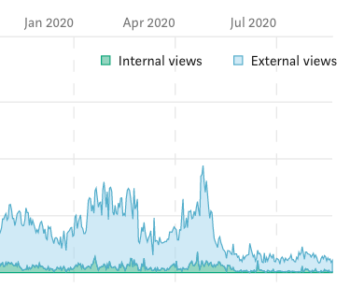
Traffic started dropping around mid-April – which does track with world events – however, at the end of February I also syndicated the contents of that self publishing post to its podcast episode here on kadavy.net.
Is Google now confused, and not sure where to send traffic? Since the post is on Medium, I don’t have access to keyword stats. I did one thing I should have done to begin with, which was to add a link to the original post as a “rel=canonical” on my syndicated post.
To be honest, I probably willingly didn’t do that, because I saw there was a ton of traffic going to this post on this other site, and I wanted that traffic on my site instead. It’s possible that this is a transitional period, but I think it’s more likely I messed up a good thing I had going.
I likely also changed a bunch of links here on kadavy.net to point to this syndicated post, rather than the original on Writing Cooperative. Naturally, I’m being defensive of my traffic. If someone is on my site, why send them to another site to get something they can get on this same site? Yet Google juice works in mysterious ways. I should probably change links back those, too. For now, I’m watching to see what happens by identifying the canonical.
Income
Book Sales
Digital Products
| Summer of Design | $21 |
| Total Digital Products | $21 |
Affiliates / Advertising
| Active Campaign | $1,829 |
| Amazon | $53 |
| ConvertKit | $71 |
| Hostgator | $200 |
| SendOwl | $5 |
| Total Affiliates | $2,158 |
Love Your Work Podcast
| Patreon | $184 |
| PayPal Donations | $5 |
| Total LYW Podcast | $189 |
Services
| Medium | $68 |
| Clarity | $0 |
| Total Services | $68 |
| GROSS INCOME | $4,963 |
Expenses
General
| Accounting | $555 |
| Outside Contractors | $64 |
| Podcast Editing / Publishing | $80 |
| Misc. Software | $90 |
| MMT Samples | $32 |
| Total General | $821 |
Advertising
| Amazon | $1,283 |
| Product Samples | $10 |
| Total Advertising | $1,283 |
Hosting
| Bookfunnel | $15 |
| Genius Link | $10 |
| Libsyn | $7 |
| Namecheap | $26 |
| SendOwl | $24 |
| Total Hosting | $82 |
| TOTAL EXPENSES | $2,186 |
| NET PROFIT | $2,777 |


